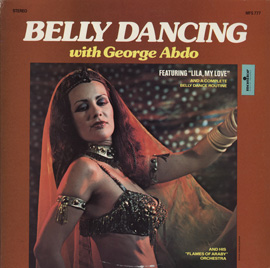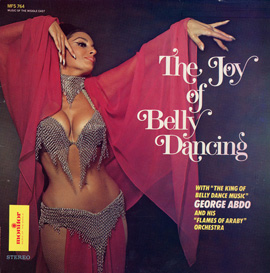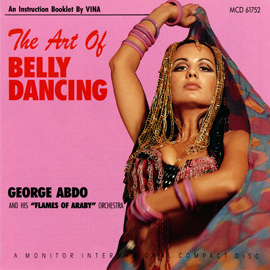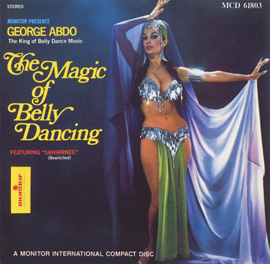Summary
This lesson examines belly dance music, performed by Lebanese-American musician George Abdo, an example of music in Arab American communities during the 1970s. Students will learn about Middle Eastern music, its transformations in the United States, and basic forms of belly dance movement.
Suggested Grade Levels: 6-8, 9-12
Country: United States
Region: East Coast
Culture Group: Arab American
Genre: Dance
Instruments: Voice, body percussion (optional: cymbals, pitched instruments)
Language: Arabic
Co-Curricular Areas: Dance, Social Studies, History
National Standards: 1, 2, 5, 6, 8, 9
Prerequisites: For Lesson Segments 2 and 3, some ability to read western musical notation
Objectives:
- Listening to music
- Learning about Arab people and music in the United States
- Identifying instruments in Arab American music
- Singing or performing on instruments, rhythms and pitch material
- Practicing basic movements of belly dance choreography in relationship to rhythm
Material:
- “Belly Dance!: The Best of George Abdo and His Flames of Araby Orchestra,” 2002 Smithsonian Folkways Recordings
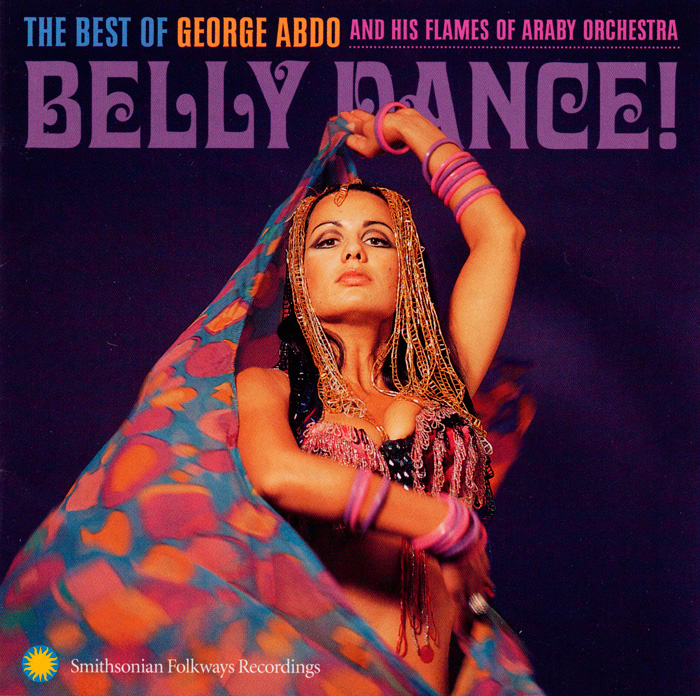
“Raks Araby (Arabic Dance)”
from Belly Dance!: The Best of George Abdo and His Flames of Araby Orchestra (2002) | SFW40458
“Allah, ya Lubnan (God, My Beautiful Lebanon)”
“Raks el Malek (Dance for the King)”
Lesson Segments:
- What is Arab American Music? (National Standards 6, 8, 9)
- Instruments and Scales (National Standards 1, 2, 5, 6, 9)
- Rhythms (National Standards 2, 5, 6, 9)
- Introducing Belly Dance Movements (National Standards 6, 8, 9)
1. What is Arab American Music?
- Play “Raks Araby” (Arabic Dance)
- Ask students where they think this music comes from. If they guess that it is from the Middle East, have them explain what elements sound Middle Eastern to them.
- This piece was recorded in 1973 by Lebanese-American musician George Abdo. While the piece incorporates many Middle Eastern musical elements (and sounds as such in its timbre and use of scales), it has also been influenced by American popular music forms such as rock and jazz.
- Ask students what they think is the function/context of the music
- Abdo’s music accompanied belly dancers. Ensembles liked his worked at Middle Eastern supper clubs, found in American cities with Arab American communities, where patrons could eat, drink, smoke, hear music, and watch dance. During the 1960s and 1970s belly dance and its associated music became popular as Americans became fascinated with its ‘exotic’ qualities. These supper clubs were an extension of hafla, a Syrian-Lebanese music party.
- Explain and discuss Arab American musical culture.
- Arab peoples arrived in the United States shortly before the beginning of the twentieth century, mostly from what was then Greater Syria (now Lebanon, Syria, Jordan, and Israel/Palestine). Many were Christian Arabs fleeing Ottoman rule.
- In America, Middle Eastern music drew from a number of influences because of collaborations between musicians of different heritages. Abdo’s influences included Syrian, Lebanese, Egyptian, Armenian, Greek, Jewish, Turkish and American.
- While there are linguistic, musical, and culinary connections among Arab and Middle Eastern countries, there are differences in religion (including Christians and Jews, not just Muslims), ethnicity, and culture. Abdo’s music drew from many of these Middle Eastern musical cultures.
- On a map, show Greater Syria and cities with large Arab American communities in the US (Los Angeles, New York City, Detroit)

Extension:
If the instructor feels that such a discussion is appropriate, have students examine cover art from Abdo’s albums. What kinds of stereotypes about Middle Eastern culture do these images represent? Why do students think that these images were prominent during the 1960s and 1970s? How have more recent events (i.e. the 9/11 terrorist attack, the wars in Iraq and Afghanistan) affected American ideas about the Middle-East, Arabs, and Arab-Americans?
Assessment:
Do students know the geography of the Arab world and are they able to identify at least one city in the US with a large Arab American population? Do students understand the similarities shared between Arab peoples (e.g. language, food, music) as well as the differences between them (e.g. religion, country, culture)?
2. In Light of Civil Rights
- Listen to “Allah, ya Lubnan” (God, My Beautiful Lebanon)
- Have students identify the kinds of instruments they here (i.e. strings, chordophones) or what kinds of instruments it sounds like.
- Describe the kinds of musical instruments used and, if possible, show photos of instruments. Darabukkah:
- Hour glass shaped drum
- Qanun: 75 string zither
- Oud: Arabic name for what is called Lute in the western world
- Electric Guitar: American influence
- Note that the timbre of electric guitar, use of amplification, and use reverb in the music all represent the influence of American popular music
- Have students play (with instruments) or sing (using solfege) a brief excerpt at time mark 00:50

- In the Middle East the term maquam refers to a set of pitches that are used for compositions and improvisation, similar to a scale or mode in western music. The augmented 2nd interval between Eb and F# will probably be perceived as sounding foreign or exotic. Middle Eastern musical systems incorporate a wide variety of intervals.

Extension:
If students have some understanding of the physics of music, explain that temperament is different between western and Middle Eastern music. Whereas western music uses equally tempered half steps (e.g. pitches demarcated with frets on a guitar), Arabic systems of music use microtones that fall between half steps. These quarter tones and their corresponding symbols are illustrated below. George Abdo’s ensemble tended to play in more western tuning for two reasons. First, it was more appealing to American listeners because it sounded more familiar. Second, because Abdo collaborated with musicians from various cultures who used various intonations, it allowed for a compromise and avoided confusion. If possible, using a piano as a pitch reference, have the students try to sing between half steps (such as C and C#). Students should not worry about the intonation, but rather try to feel a distinct pitch emerge in between the notes of a piano.
Assessment:
Are students able to play or sing the short excerpt? Are they able to articulate differences between Middle Eastern and American musical influences in Abdo’s work (e.g. use of instruments, timbre, pitch material)?
3. Rhythms
- Listen to “Raqs Araby” again
- Identify beat and underlying pulse
- Most Arab American music is in duple meter (just like most American popular music). Dancers tend to choreograph their work using counts of 8 beats. Students should count in 8 to prepare for dance movements.
- Tap or play (using any kind of percussion) the opening rhythmic motive played on the finger cymbals

- Finger cymbals are usually played by the dancer herself. Rather than just tapping, have students pantomime playing the cymbals by pressing their pointer and middle fingers onto their thumb. Students may have a hard time tapping the rhythm once other percussion instruments enter and layer other rhythms above the cymbal pattern. The layering of rhythms is reflected in the dance choreography, as students will learn in the next lesson. Dancing while playing a rhythm on fingers cymbals can be very difficult.
Assessment:
Are students able to count 8 beat patterns? Are they able to play the simple cymbal pattern along with the recording?
4. Dance: Introducing Belly Dance Movements

- Play “Raks el-Malek” (Dance for the King), starting around 01:15 after the introductory improvisation, once the piece is in steady rhythm. Make sure volume isn’t too loud to talk over.
- This is a slow, polyrhythmic piece that will be used for students to try basic forms of belly dance movement. There are many forms of belly dance practiced in America and there are debates among scholars about whether American belly dance is an authentic continuation of Middle Eastern cultural practices. Even during the time of Abdo’s recordings, most of the women who danced in America were not of Middle Eastern descent. The point of this excursion is to give students a chance to practice improvising choreography in relationship to rhythm. The movements used here are basic ones that I have encountered in a variety of belly dance classes.
- Practice walking in rhythm, using 8-beat count
- This allows students to begin moving in rhythm to the music. While belly dance movements are often done standing in place, travelling steps, entrances, and exits all require the dancer to be able to move in rhythm.
- Demonstrate movement at different levels that can be combined and layered in whatever way is comfortable for the student
- Have students stand in one spot to practice these movements. I have chosen these movements to emphasize the layering that goes into belly dance choreography. Dancers practice isolated movements of different levels of their body (shoulders, torso, hips, etc.) that they are then able to combine. Thus, the dance becomes a visual representation of the music’s rhythmic intricacy.
- Snake Arms: Hold arms out at the side. In order to create a snake- or wave-like movement of the arms, rotate arms out from the shoulders, and let the rotation flow through the shoulders and wrists. As a variation, the arms can move from the front of the body.
- Slide Ribcage: Keeping arms out to the side (or hands on hips) and hips stationary, shift the weight of the ribcage right, back center, and then left. Imagine your sternum is drawing a straight line in the air.
- Hip Shimmies: There are several types of shimmies but the easiest to do is accomplished through the knees. Bend knees slightly and stabilize body weight. Alternate straightening one knee while bending the other deeper. When repeated quickly, the hip should naturally sway to adjust for the change of weight.
- Hip Bumps: These are good when used for rhythmic hits (not a steady beat, just a beat that is emphasized by a percussionist. The easiest way to do this is to imagine that you are trying to bump something with the side of your hip. If you have ever struggled to close a car door while carrying a load of groceries and have used your hips to shut a door that last inch, that is the basic movement.
Assessment:
Are students incorporating basic movements while dancing to the music? Do their movements reflect the rhythms of the music?



